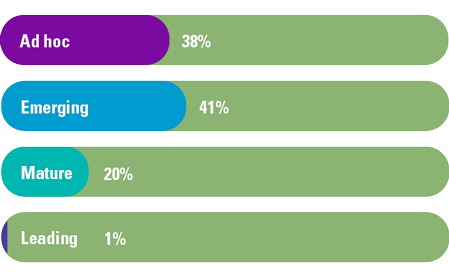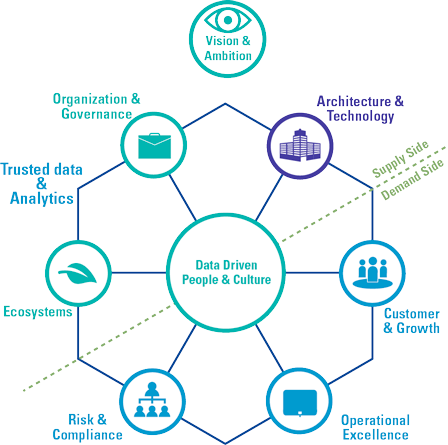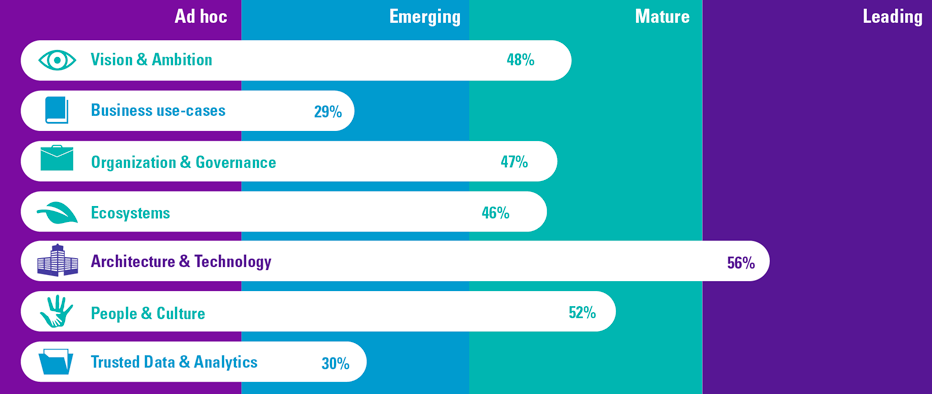This article describes the current Data & Analytics maturity level of organizations in The Netherlands and more specifically the unique selling points of “leading” organizations from a Data & Analytics perspective. This brief article comprises a summary of the report “The importance of a data mature organization in the new reality” ([KPMG21]) that was released in June 2021, and was the result of a Data Maturity survey conducted among approximately 100 organizations.
The three key elements of the success of Data & Analytics Leaders are:
- having and following a solid Data & Analytics strategy
- being able to measure and to track the value that Data & Analytics brings
- having a fully committed senior leadership that is helping to drive the data analytics transformation.
We will address and analyze these key elements that support the acceleration of data-driven transformation in more detail in this article.
Introduction
Over more than a year, Covid-19 has created and shaped new challenges for all organizations. Most people and organizations overcame the initial stress situation and proved how flexible we as human beings can be to adapt to new situations. Living in the pandemic for over a year, many got “used” to “a” or “the” new reality, but at the same time the real “new normal” is still awaiting us. One thing is for certain, things will never go back to the way they were. We should expect substantial developments in leveraging data and new technologies in the years ahead. Several of these developments within and between organizations as well as in entire sectors will therefore be strongly data- and technology-driven.
KPMG has conducted a survey to obtain an understanding of the Data & Analytics maturity and associated outlook of organizations in the Netherlands. We were eager to see where Dutch organizations stand today and what key steps are being taken to further accelerate their data-driven transformation. KPMG experience was combined with results of the “Data & Analytics Maturity Survey” conducted between October – December 2020. The online survey garnered responses from around 100 selected participants representing the full range of industry sectors, organization sizes, functional specialties, and tenures to be able to provide a holistic view of the data analytics maturity in the Netherlands.
For this survey, KPMG’s strategic pillar framework for data-driven organizations was used to structure the questionnaire. We have been using and improving this framework in our expanding Data & Analytics practice.
Becoming more data-driven is one of the key priorities for most organizations nowadays. We see that truly data-driven organizations are growing faster than the traditional ones ([Gott17]). This leads to serious investments of almost every organization improving its Data & Analytics capability and looking for a way to drive value based on Data & Analytics.
However, as a result of the survey we conducted in the Dutch market, we still see that most organizations in the Netherlands still have a relatively low Data & Analytics (D&A) maturity. Figure 1 shows that only 21% can be perceived as data-mature organizations and 79% of respondents are relatively immature in their data-driveness. This is mainly because scaling up successfully with Data & Analytics does not only implicate investing in technology, infrastructure and hiring a few data scientists. Becoming a data-driven organization also requires changes in (data) culture, operating model and realizing “real” business value through use cases. Getting these three conditions right appears to be very challenging for many organizations.
Figure 1. Overall Data & Analytics Maturity in the Netherlands. [Click on the image for a larger image]
Connecting business demand with Data & Analytics supply
The last 5 to 10 years, organizations have focused mainly on investing in the fundamental conditions for becoming a data-driven organization, with particular attention to the technical data foundations, building up an ecosystem of technology/knowledge partners, creating awareness on the importance of Data & Analytics internally and embarking on a few initial Data & Analytics experiments. It became clear that the Data & Analytics transformation is a long and complex journey that requires attention to multiple or all required preconditions. To be able to bring things together and construct a view on what you need to do when, we currently see that many organizations have or are working on a specific data strategy.
In the survey, 65% of the respondents mentioned they have developed such a data strategy outlining the role and importance of Data & Analytics within the organization, establishing the roadmap for what’s ahead. However, value is only created when the strategy is effective and executed in the right way. This is easier said than done. Given the lower overall Data & Analytics maturity levels, we can assume that for some respondents this still mean that they have just started with their strategy and vision document.
To be able to structurally drive value from Data & Analytics, multiple pieces of a complex puzzle need to come together. The question is how to define and select the right use cases that can both deliver value and help further structure and improve the elements of the “supply side” to accelerate the realization of future use cases. To support organizations in grasping this, we work with the strategic pillar model for a data-driven organization (see Figure 2).
Figure 2. The key strategic topics of KPMG’s Seven Pillar Model. [Click on the image for a larger image]
These are the key strategic topics to becoming a data-driven organization:
Vision & Ambition: How should data contribute to our long-term strategic business goals (e.g. operational excellence, customer interaction, new products/services, etc.)? The data strategy should also indicate which initiatives should be launched to help realize strategic business goals via Data & Analytics use cases. Based on this Vision & Data Strategy the following seven pillars can be defined and implemented:
- Organization & Governance: What target operating model and which assignment of responsibilities are required to successfully execute and support our data initiatives?
- Ecosystems: What are our key partners with whom we need to work together to be able to drive value through Data & Analytics, and how to collaborate on this topic? This can be both technology partners, but also for example suppliers/buyers in your value chain.
- Risk & Compliance: Can we identify the relevant external and internal regulatory and compliance requirements and data-related risks (e.g. data privacy, data retention, data residency, etc.), and reduce or eliminate these risks by applying (ethical) controls? Addressing this pillar in the right way and ensuring the quality of and transparency in the data and algorithms used can increase the trust in our data analytics.
- Operational Excellence: Which principles should we apply to organize our data analytics efforts in a standardized, simplified and efficient manner?
- Customer & Growth: Which Data & Analytics customers should we involve to tailor our use cases for the right target audience? And how can we ensure that the value can be reaped of the data analytics initiatives for their growth?
- Architecture & Technology: Which technologies do we need to leverage for a flexible and scalable data platform to support the development and deployment of our Data & Analytics use cases?
- Data-driven People & Culture: How to create a data-driven culture and data literacy across the workforce (with both internal and external resources)?
Using this model helps organizations to better understand their strong and improvement areas with respect to the crucial aspects of Data & Analytics. Providing the right focus on the aspects that are currently your weakest link is vital to be able to make progress.
Figure 3. Maturity of respondents’ organization for each of the strategic pillars. [Click on the image for a larger image]
Figure 3 shows the maturity of the respondents for each of the strategic pillars. The first observation is that the maturity on the Architecture & technology pillar is much higher than all others. For instance, 70% of respondents indicated that appropriate data tooling is in place across the data value chain. This outcome is in line with our own observations, as our clients have typically made significant investments in Data & Analytics technology and are now trying to reap the benefits. In addition, the Data-driven people & culture and Ecosystem pillars score relatively high. We have been advising several organizations on making the organization more data-driven and are struggling to interpret this response. Undoubtedly, steps are taken to hire specific expertise on data science (People & culture pillar) and on setting up relations with parties active on the supply side, like cloud and AI solution providers (Ecosystem pillar).
However, based on experience we can say that many organizations still need to strengthen their competencies when it comes to adapting a truly wide-spread data-driven culture. The term “data literacy ” is relevant in this context. In a data-literate organization, all employees, not just data scientists, need to be able to assess the data, find meaning in the numbers and derive actionable business insights from it. Furthermore, many organizations are still in the early stages of integrating data analytics into their operational processes, and ecosystems are rarely extended on the business side. This is confirmed by our survey, which shows that use cases are still in an emerging stage. In our opinion, the inconsistency in the maturity between the “demand” and “supply side” is one of the main challenges that organizations have to address, as it is illustrative for the gap between investments and returns.
Key challenge of generating business value with Data & Analytics
There is another challenge for bridging the gap between investments and returns. This is the ability to measure the value of Data & Analytics initiatives. This brings both opportunities as well as challenges for organizations on their journey to become digital leaders. Overall, only 45% of organizations can measure the value of Data & Analytics. Given the huge investments being made within Data & Analytics, this is quite a surprising outcome. However, if we look at the “Mature” and “Leading” organizations among the respondents, the situation is very different: 95% of them measure their data-driven value. Being able to prove value helps to unlock new investments more easily, which might increase the gap between leading and emerging organizations even further. The ability to measure value is an important success factor and can metaphorically be seen as the required “compass” for organizations to keep going in the right direction for their transformation. Among the organizations that do measure value, we see that 64% managed to increase their revenues by more than 10% in the last 12 months. Most of these organizations are the digital leaders in developing and applying Data & Analytics solutions.
Three key pillars to help ensure Data & Analytics initiatives deliver business value
We see three key pillars that help ensure that Data & Analytics initiatives deliver true business value, which can be tracked in an efficient way:
- “Business value first” principle
- Clear governance and supportive tooling
- Specific methods for D&A value tracking
Ad A. Any initiative must result in tangible business value – and this principle needs to be followed throughout the lifecycle of each initiative. From the first moment of business case development, all initiatives must be linked to one or more of the agreed business KPIs. This includes specifying concrete drivers through which business benefits will be reached, agreeing on the general cause-effect relationship, and making explicit any assumptions. Inputs from both the business and technology owners are required.
Ad B. Secondly, a clear governance should span the process from business case setup to benefit validation, involving stakeholders across the business. Successful governance setups involve stakeholders from both the technology and the business side of the organization. Here, accountability lies with a single person (typically the business owner) and a process with clear roles and responsibilities is in place for defining and approving initiatives, as well as tracking and validating benefits once launched.
Ad C. Lastly, given the specific nature of Data & Analytics initiatives, linking technical KPIs to true business value typically requires specialized methods tailored to the use case. Depending on the use case, various methods can be used to track the value of data analytics applications in dynamic environments.
The important elements of leading data-driven organizations
The results of our survey show that “Leading” and “Mature” organizations among the respondents are not only the most advanced in setting up their Data & Analytics operations, these organizations have also been able to achieve the highest returns on investment with their Data & Analytics endeavor. They are achieving the best results both in terms of revenue increase and cost reduction through Data & Analytics initiatives.
We analyzed what makes these organizations stand out from the pack and identified that the key differences are in the strategic, organizational and cultural elements that are established within their organization. It may not come as a surprise, but the three concrete elements that came out on top for leading Data & Analytics organizations are:
- A solid and clear data strategy as a starting point
- Full commitment from senior leadership
- Value management and benefits tracking throughout the use case lifecycle
Ad A. Defining, communicating and embedding a solid data strategy is one of the first steps in becoming at a Mature level, since the entire 100% of Leading and Mature organizations have defined theirs compared with only 60% of the less mature organizations. In our experience, when developing a data strategy, a critical success factor is a clear focus on the connection between the business demand and Data & Analytics supply (i.e. technology, capabilities and processes to execute Data & Analytics use cases effectively). The elements that need to be addressed in such a data strategy are mentioned earlier and are visualized in the Seven Pillar Model.
Ad B. One element where we see a significant difference between leaders and laggers is related to the organization’s data culture: a leadership that is fully committed to Data & Analytics initiatives and is stimulating data-driven decision-making throughout the organization, is a key foundation for success. However, stakeholder awareness and commitment are difficult elements to influence, but a critical prerequisite for increasing digital maturity and data literacy. Strong data culture is built on the definition of a data strategy, strong commitment to an investment scenario, embedding the right capabilities and effective communication across the organization.
Ad C. Lastly, the key challenge for organizations to be able to measure the value of their data analytics initiatives. As mentioned, there is strong divide between high and low maturity organizations, since only 32% of low maturity organizations manage to measure value. We believe that successful Value management encompass the end-to-end value chain, from the definition of the (expected value of) use cases to the monitoring of the actual benefits.
Conclusion
“Leading” organizations in Data & Analytics do a few things different and better than lagging organizations. The key three elements are working with a solid data strategy, measuring the business value that Data & Analytics brings, and having fully committed senior leadership that helps drive and trigger the change. Measuring value will help find the right direction in complex transformation processes of organizations.
The complexity of becoming a more data-driven organization, as we see it, is not the complexity of one of the elements or pillars (for example, technology , people, organizational design, etc.); it is mainly related to the need to work holistically and simultaneously on many topics and challenges. As KPMG we have been working in a holistic and integrated manner with our clients over the last years to help drive their Data & Analytics transformation by supporting our client to make the necessary progress on all the strategic pillars of a data-driven organization.
The authors thank Asher Mahmood, Senior Manager Data & Analytics at KPMG, for his assistance in writing this article.
References
[GottT17] Gottlieb, J. & Rifai, K. (2017, December). Fueling growth through data monetization. McKinsey survey. Retrieved from: https://www.mckinsey.com/business-functions/mckinsey-analytics/our-insights/fueling-growth-through-data-monetization
[KPMG21] KPMG (2021, June). The importance of a data mature organization in the new reality. Retrieved from: https://home.kpmg/nl/nl/home/insights/2021/06/a-data-mature-organization-in-the-new-reality.html








